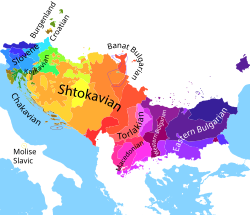Influence on South Slavic languages

Bulgarian and Macedonian
Romanian influence is most visible on South Slavic languages, in particular Bulgarian and Macedonian which goes back to the earliest centuries after the invasion of Slavic tribes in the south-Danubian territory. The lexical borrowings dominate in its shepherd and dairy-farming terminology, for example: fičor ‘young shepherd’ ← ficior, zira ‘whey’ ← zer. [1] Linguist Maria Osman-Zavera discusses more than 200 lexical units of Romanian provenience in Bulgarian dialects. [2] Of these words most refer to: [3]
- pastoral activities: batut, čotura, faša, fičor, furka, gušav, kačula, kapuš, karam, karuca, katun, keptarče, kolastra, korda, koruna, kostura, kupa, mačuka, mandzara, murg, muskur, samar, sapun, scrum, splina, tufa, turma, turta, urda.
- animal and plant names: barza, botrak, buhăr, buăr, čokărlan, gagarica, kupoi, melčo, omida, paun, puika, vultur, bučimiš, floričika, foienfir, muškato, papura, vica.
- house and household items: acă, arnic, baer, burkan, boture, čarčaluša, flutur, kăstron, kl′anca, koptor, lešija, masa, năstur, pahar, pakura, palaria, pana, papuša, pat, pod, rasučala, skurteika, speteazi, zăbun, zestre.
- food: kuzunači, malai, mamaliga.
- body: burta, buza, bašăka (bășică), kăpăčină, konč, luna, moc, soarta.
Of various categories are: bezna, dižma, draptŭno, gluma, krecavo, maruncăkă, mut, pučos, vitrig, blănda, kaluš, kaprar, kičera, lauta, lingură, moš, mošija, nunko, pastrija, pomana, puškaria, rudžina, vataf. [4]
The discourse marker май (maĭ) in Bulgarian is unanimously accepted as a Romanian loan [5] while Aromanian seemed to have been the calque-source for the possessive perfect in Macedonian, as well as it could have calqued the l-perfect from Macedonian. [6]
Serbo-Croatian and Slovene

Examples of words that entered Serbo-Croatian at wider level: brnduša < brândușă (crocus), burdelji < bordei (hut, cottage), kaš < caș (a type of cheese), čutura < ciutură (wooden vessel for wine or brandy), kustura < custură (a rocky promontory), mamaliga < mămăligă (polenta), pujka < puică (young little hen). [7]
Istro-Romanian contributed to Croatian and Slovene regional lexes in Istrian Peninsula: birikata, glindura (Ro. ghindură < Lat. glandula), degečkati in Croatian and gadȉčkati in Slovene, mugara, petrikati, puca, sugati, šurla, žinžire. Words like bata (Ro. baltă) and čuma (Ro. ciumă) are also considered loanwords from Istro-Romanian in the region, although their ultimate etymology is disputed. [8] On Krk island in Croatia, where a community of Morlachs was settled from the 15th century, further words such as špilišôr (Romanian spinișor) or čȕra, čȕralo (ciur in Istro-Romanian - colander) entered the local language. [9]
Words entered the Serbo-Croatian vocabulary at the early Common Romanian stage, as well. клùсура, meaning "mountain pass", is a loanword from Greek which in turn borrowed it from Proto-Romanian, [10] and antrešelj meaning "gap in the middle of a pack saddle", comes from a Proto-Romanian form of Vulgar Latin *intersellum. [11]

